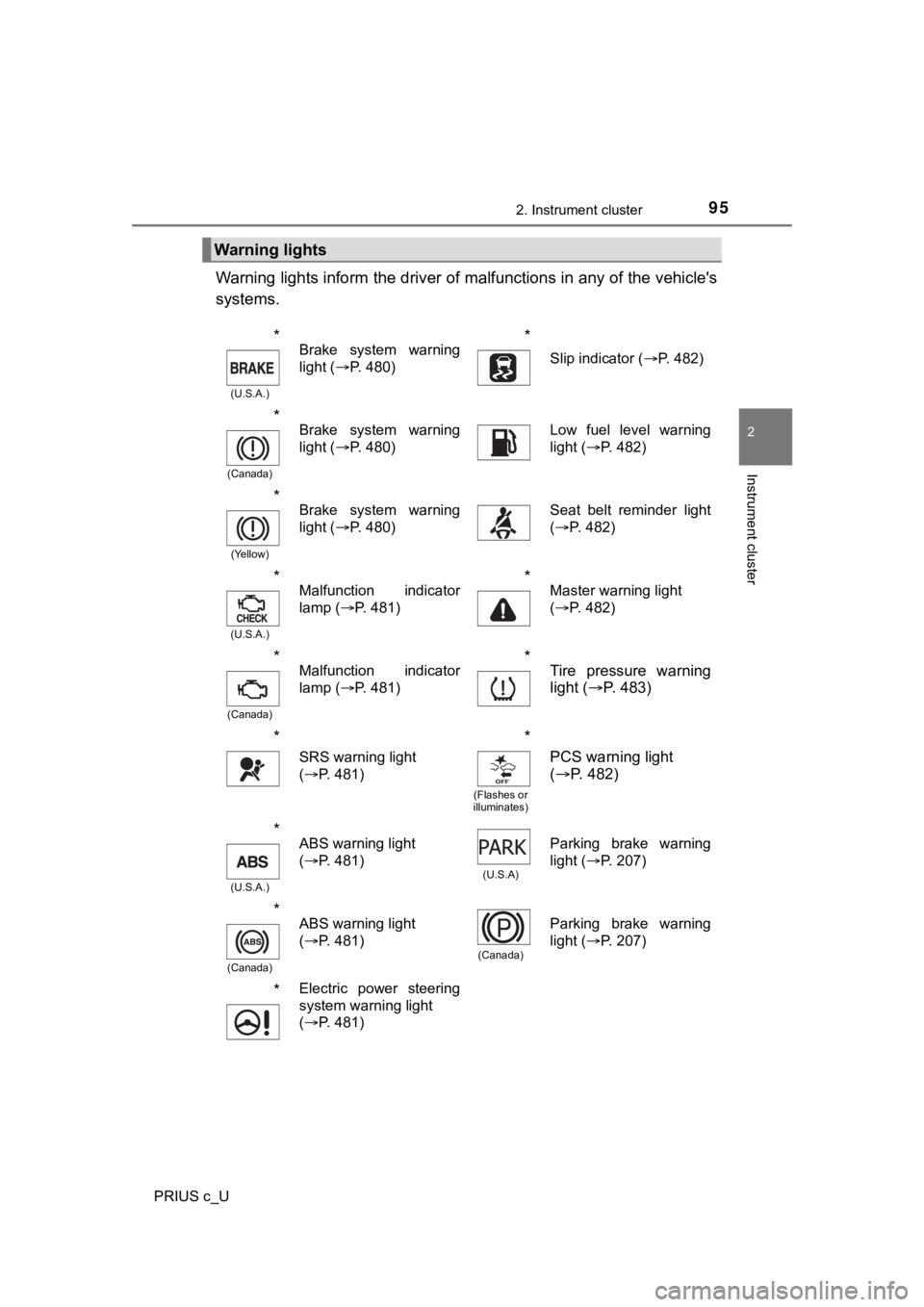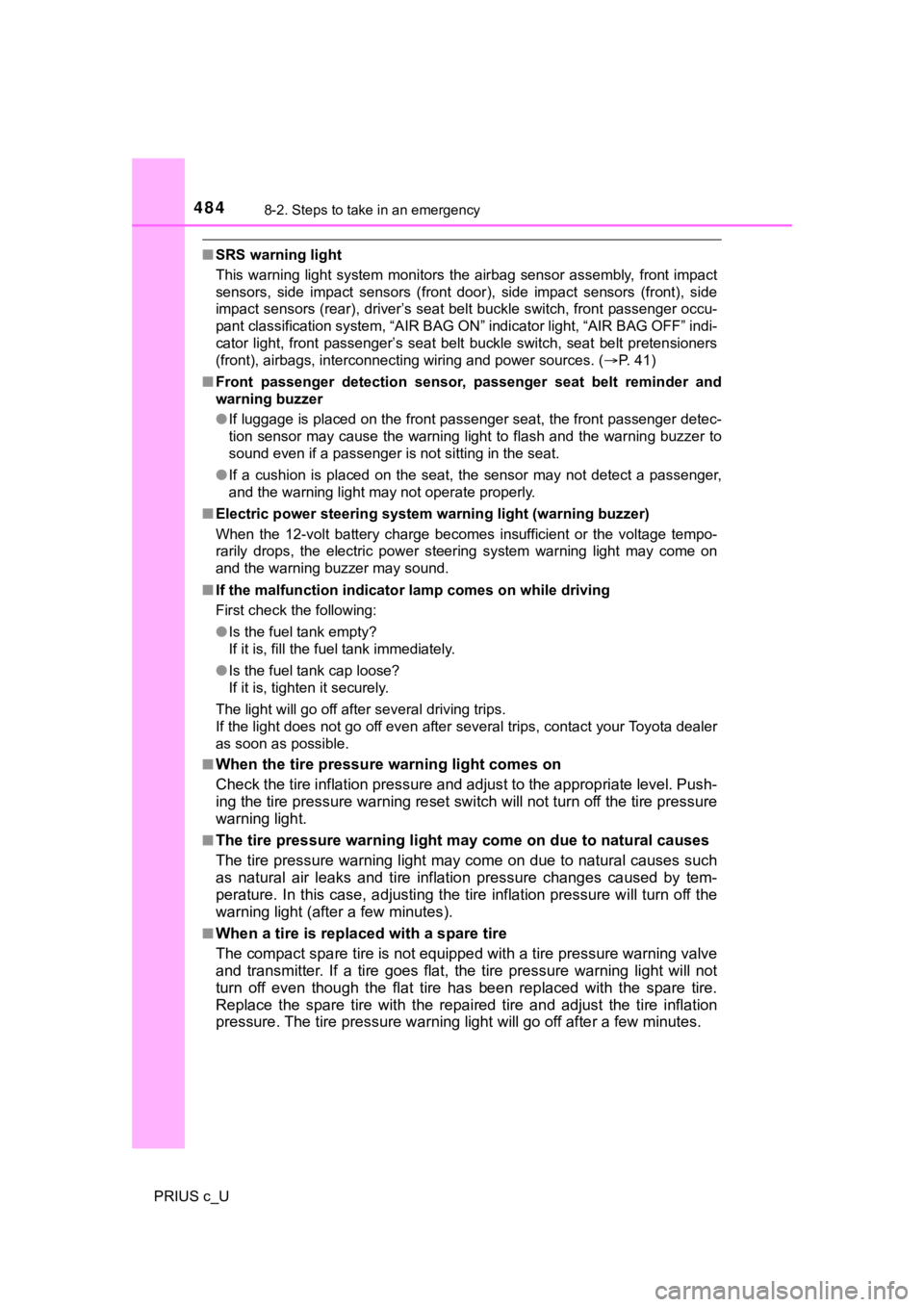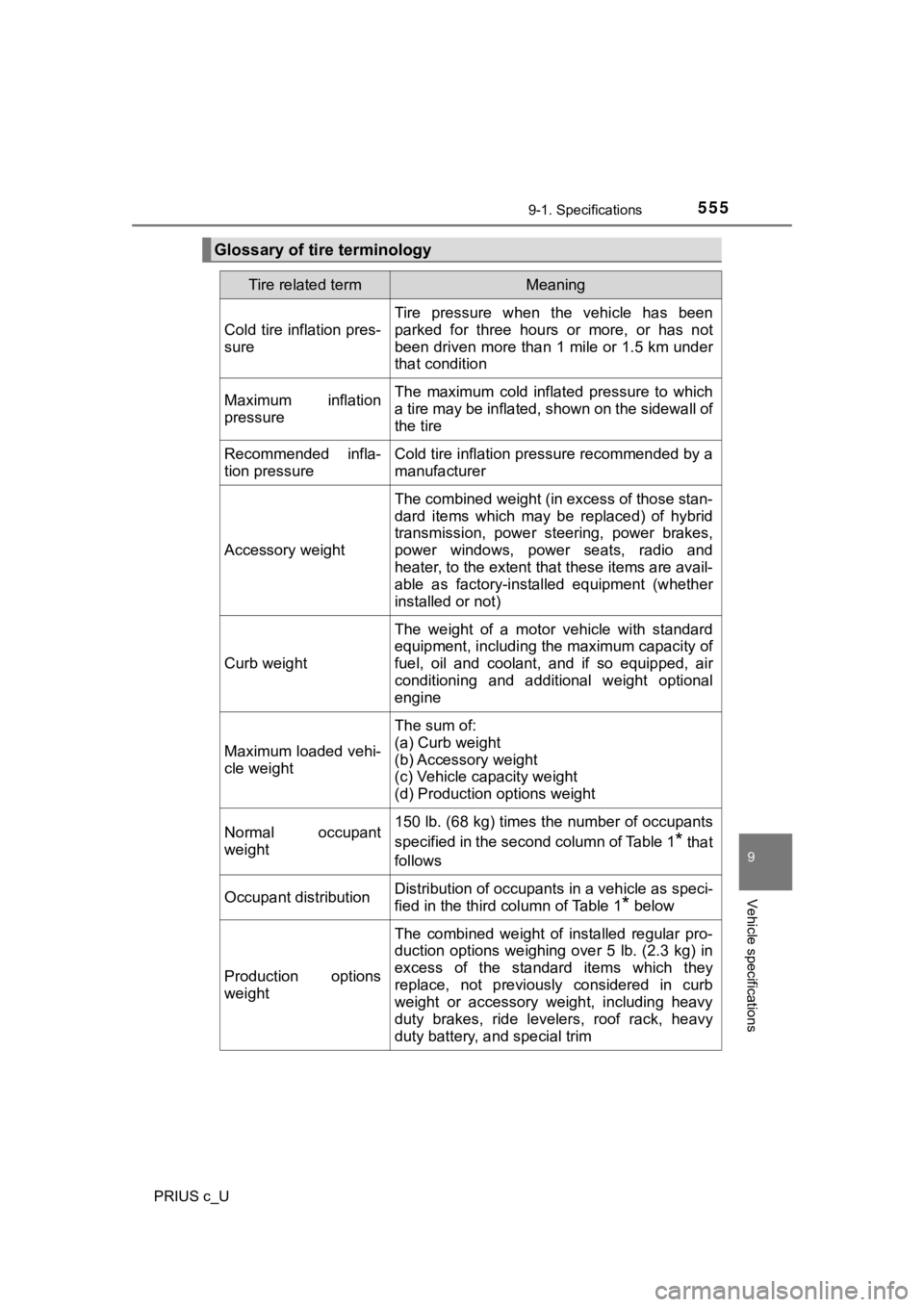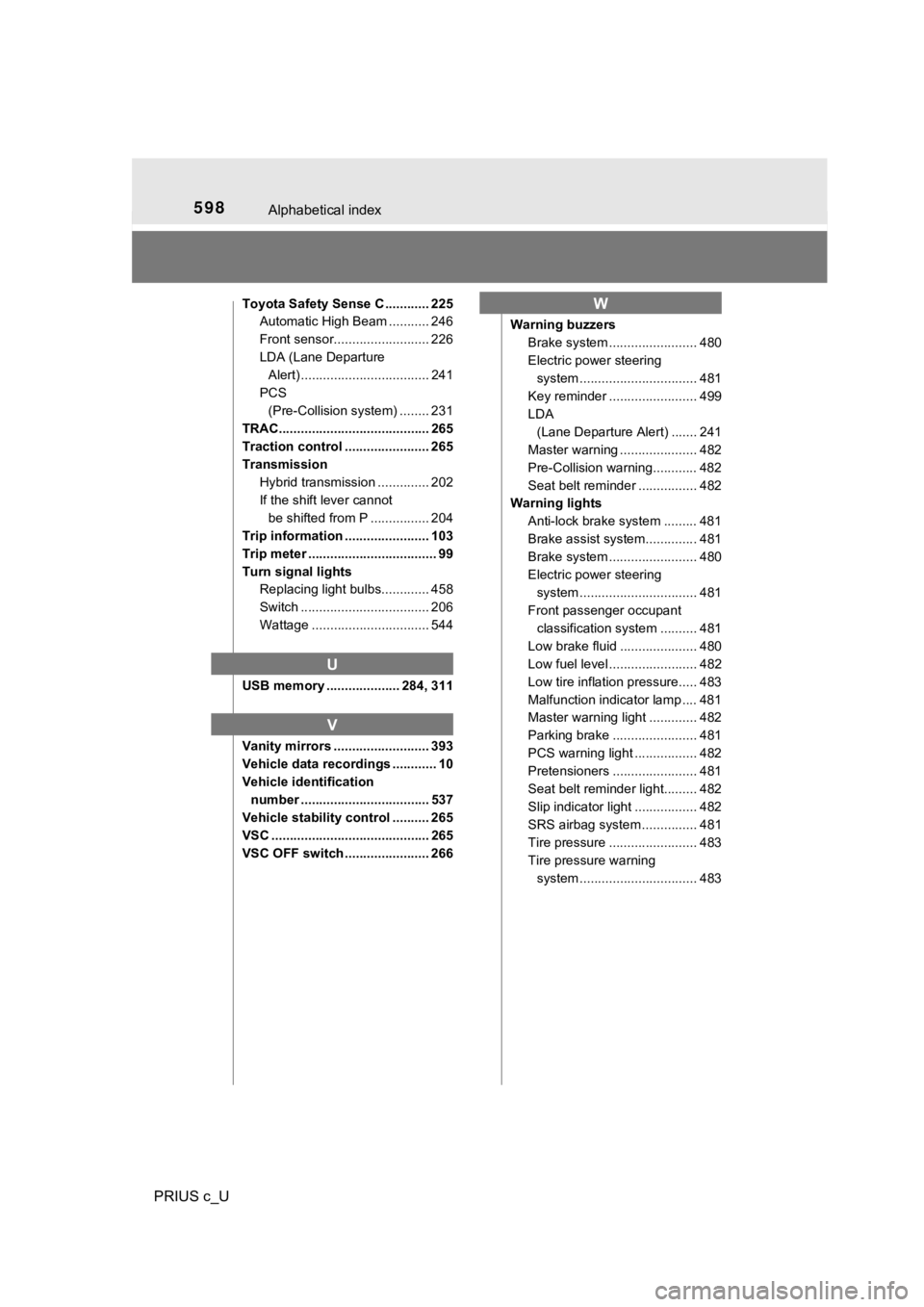fuel pressure TOYOTA PRIUS C 2020 Owners Manual
[x] Cancel search | Manufacturer: TOYOTA, Model Year: 2020, Model line: PRIUS C, Model: TOYOTA PRIUS C 2020Pages: 600, PDF Size: 12.02 MB
Page 17 of 600

17Pictorial index
PRIUS c_UWindshield wipers . . . . . . . . . . . . . . . . . . . . . . . . . . . . . . . . . P. 214
Precautions against winter season . . . . . . . . . . . . . . . . . . . . . P. 274
Fuel filler door . . . . . . . . . . . . . . . . . . . . . . . . . . . . . . . . . . . . P. 221
Refueling method . . . . . . . . . . . . . . . . . . . . . . . . . . . . . . . . . . . P. 221
Fuel type/fuel tank capacity . . . . . . . . . . . . . . . . . . . . . . . . . . . P. 538
Tires . . . . . . . . . . . . . . . . . . . . . . . . . . . . .
. . . . . . . . . . . . . P. 435
Tire size/inflation pressure . . . . . . . . . . . . . . . . . . . . . . . . . P. 543
Winter tires/tire chain . . . . . . . . . . . . . . . . . . . . . . . . . . . . . P. 274
Checking/rotation/tire pressur e warning system . . . . . . . . .P. 435
Coping with flat tires . . . . . . . . . . . . . . . . . . . . . . . . . . . . . . P. 505
Hood . . . . . . . . . . . . . . . . . . . . . . . . . . . . . . . . . . . . . . . . . . . . P. 419
Opening . . . . . . . . . . . . . . . . . . . . . . . . . . . . . . . . . . . . . . . . . . P. 419
Engine oil . . . . . . . . . . . . . . . . . . . . . . . . . . . . . . . . . . . . . . . . . P. 539
Coping with overheat . . . . . . . . . . . . . . . . . . . . . . . . . . . . . . . . P. 529
Headlights/daytime running lights . . . . . . . . . . . . . . . . . . . . P. 208
Parking lights/front turn signal lights . . . . . . . . . . . . . P. 206, 208
Side turn signal lights . . . . . . . . . . . . . . . . . . . . . . . . . . . . . . P. 206
Front fog lights
*. . . . . . . . . . . . . . . . . . . . . . . . . . . . . . . . . . . P. 212
Front side marker lights . . . . . . . . . . . . . . . . . . . . . . . . . . . . P. 208
Stop lights/tail lights /rear side marker lights/
rear turn signal lights . . . . . . . . . . . . . . . . . . . . . . . . . . P. 206, 208
Back-up lights
Shifting the shift lever to R . . . . . . . . . . . . . . . . . . . . . . . . . . . . P. 202
License plate lights . . . . . . . . . . . . . . . . . . . . . . . . . . . . . . . . P. 208
4
5
6
7
Light bulbs of the exterior lights for driving
(Replacing method: P. 458, Watts: P. 544)
*: If equipped
8
9
10
11
12
13
14
15
Page 95 of 600

952. Instrument cluster
2
Instrument cluster
PRIUS c_U
Warning lights inform the driver of malfunctions in any of the vehicle's
systems.
Warning lights
*
(U.S.A.)
Brake system warning
light ( ď‚®P. 480)*
Slip indicator ( ď‚®P. 482)
*
(Canada)
Brake system warning
light (ď‚®P. 480)Low fuel level warning
light (ď‚®P. 482)
*
(Yellow)
Brake system warning
light (ď‚®P. 480)Seat belt reminder light
(ď‚®P. 482)
*
(U.S.A.)
Malfunction indicator
lamp ( ď‚®P. 481)*Master warning light
(ď‚®P. 482)
*
(Canada)
Malfunction indicator
lamp ( ď‚®P. 481)*Tire pressure warning
light (ď‚®P. 483)
*
SRS warning light
(ď‚®P. 481)
*
(Flashes or
illuminates)
PCS warning light
( ď‚® P. 4 8 2 )
*
(U.S.A.)
ABS warning light
(ď‚®P. 481)
(U.S.A)
Parking brake warning
light ( ď‚®P. 207)
*
(Canada)
ABS warning light
(ď‚®P. 481)
(Canada)
Parking brake warning
light ( ď‚®P. 207)
*Electric power steering
system warning light
(ď‚®P. 481)
Page 272 of 600

2724-7. Driving tips
PRIUS c_U
â—†Delays
Repeated acceleration and deceleration, as well as long waits at
traffic lights, will lead to bad fuel economy. Check traffic re ports
before leaving and avoid delays as much as possible. When drivi ng
in a traffic jam, gently release the brake pedal to allow the v ehicle to
move forward slightly while avoiding overuse of the accelerator
pedal. Doing so can help control excessive gasoline consumption.
â—†Highway driving
Control and maintain the vehicle at a constant speed. Before st op-
ping at a toll booth or similar, allow plenty of time to releas e the
accelerator and gently apply the brakes. A greater amount of el ec-
trical energy can be regenerated when slowing down.
â—†Air conditioning
Use the air conditioning only when necessary. Doing so can help
reduce excessive gasoline consumption.
In summer: When the ambient tempe rature is high, use the recircu-
lated air mode. Doing so will help to reduce the burden on the air
conditioning system and reduce fuel consumption as well.
In winter: Because the gasolin e engine will not automatically cut out
until it and the interior of the vehicle are warm, it will cons ume fuel.
Also, fuel consumption can be improved by avoiding overuse of t he
heater.
â—†Checking tire inflation pressure
Make sure to check the tire inflation pressure frequently. Impr oper
tire inflation pressure can cause poor fuel economy.
Also, as snow tires can cause large amounts of friction, their use on
dry roads can lead to poor fuel economy. Use tires that are app ro-
priate for the season.
â—†Luggage
Carrying heavy luggage will lead to poor fuel economy. Avoid carry-
ing unnecessary luggage. Installing a large roof rack will also cause
poor fuel economy.
Page 445 of 600

4457-3. Do-it-yourself maintenance
7
Maintenance and care
PRIUS c_U
After completing the tire inflation pressure measurement and
adjustment, apply soapy water to the valve and check for leakage.
Put the tire valve cap back on.
â– Tire inflation pressure check interval
You should check tire inflation p ressure every two weeks, or at least once
a month.
Do not forget to check the spare.
â– Effects of incorrect tire inflation pressure
Driving with incorrec t tire inflation pressure may result in th e following:
â—ŹReduced fuel economy
â—ŹReduced driving comfort and poor handling
â—ŹReduced tire life due to wear
â—ŹReduced safety
â—ŹDamage to the drive train
If a tire needs frequent inflating , have it checked by your Toyota dealer.
â– Instructions for checking tire inflation pressure
When checking tire inflation p ressure, observe the following:
â—ŹCheck only when the tires are cold.
If your vehicle has been parked for at least 3 hours or has not been
driven for more than 1 mile or 1.5 km, you will get an accurate cold tire
inflation pressure reading.
â—ŹAlways use a tire pressure gauge.
It is difficult to judge if a tire is properly inflated based o nly on its appear-
ance.
â—ŹIt is normal for the tire inflation pressure to be higher after driving as
heat is generated in the tire. Do not reduce tire inflation pre ssure after
driving.
â—ŹNever exceed the vehicle capacity weight.
Passengers and luggage weight should be placed so that the vehi cle is
balanced.
5
6
Page 484 of 600

4848-2. Steps to take in an emergency
PRIUS c_U
â– SRS warning light
This warning light system monitors the airbag sensor assembly, front impact
sensors, side impact sensors (front door), side impact sensors (front), side
impact sensors (rear), driver’s seat belt buckle switch, front passenger occu-
pant classification system, “AIR BAG ON” indicator light, “AIR BAG OFF” indi-
cator light, front passenger’s seat belt buckle switch, seat be lt pretensioners
(front), airbags, interconnecting wiring and power sources. (ď‚® P. 41)
â– Front passenger detection senso r, passenger seat belt reminder and
warning buzzer
â—Ź If luggage is placed on the front passenger seat, the front pas senger detec-
tion sensor may cause the warning light to flash and the warnin g buzzer to
sound even if a passenger is not sitting in the seat.
â—Ź If a cushion is placed on the seat, the sensor may not detect a passenger,
and the warning light may not operate properly.
â– Electric power steering system wa rning light (warning buzzer)
When the 12-volt battery charge becomes insufficient or the vol tage tempo-
rarily drops, the electric power steering system warning light may come on
and the warning buzzer may sound.
â– If the malfunction indicator lamp comes on while driving
First check the following:
â—ŹIs the fuel tank empty?
If it is, fill the fuel tank immediately.
â—Ź Is the fuel tank cap loose?
If it is, tighten it securely.
The light will go off after several driving trips.
If the light does not go off even after several trips, contact your Toyota dealer
as soon as possible.
â–
When the tire pressure warning light comes on
Check the tire inflation pressure and adjust to the appropriate level. Push-
ing the tire pressur e warning reset switch will not turn off the tire pressure
warning light.
â– The tire pressure warning light may come on due to natural caus es
The tire pressure warning light may come on due to natural caus es such
as natural air leaks and tire inflation pressure changes caused by tem-
perature. In this case, adjusting the tire inflation pressure w ill turn off the
warning light (afte r a few minutes).
â– When a tire is replace d with a spare tire
The compact spare tire is not equipped with a tire pressure war ning valve
and transmitter. If a tire goes flat, the tire pressure warning light will not
turn off even though the flat tire has been replaced with the s pare tire.
Replace the spare tire with the repaired tire and adjust the ti re inflation
pressure. The tire pressure war ning light will go off after a few minutes.
Page 486 of 600

4868-2. Steps to take in an emergency
PRIUS c_U
WARNING
â– Maintenance of the tires
Each tire, including the spare (if provided), should be checked monthly
when cold and inflated to the inflation pressure recommended by the
vehicle manufacturer on the vehicle placard or tire inflation p ressure
label (tire and load information label). (If your vehicle has t ires of a dif-
ferent size than the size indica ted on the vehicle placard or tire inflation
pressure label [tire and load information label], you should de termine
the proper tire inflation p ressure for those tires.)
As an added safety feature, your vehicle has been equipped with a tire
pressure monitoring system (TPMS -tire pressure warning system) that
illuminates a low tire pressure telltale (tire pressure warning light) when
one or more of your tires is significantly under-inflated. Acco rdingly,
when the low tire pressure telltale (tire pressure warning ligh t) illumi-
nates, you should stop and check your tires as soon as possible , and
inflate them to the proper pressure. Driving on a significantly under-
inflated tire causes the tire to overheat and can lead to tire failure.
Under-inflation also reduces fuel efficiency and tire tread lif e, and may
affect the vehicle’s handl ing and stopping ability.
Please note that the TPMS (tire pressure warning system) is not a sub-
stitute for proper tire maintena nce, and it is the driver’s responsibility to
maintain correct tire pressure, even if under-inflation has not reached
the level to trigger illumination of the TPMS low tire pressure telltale (tire
pressure warning light).
Your vehicle has also been equipped with a TPMS (tire pressure warn-
ing system) malfunction indicato r to indicate when the system is not
operating properly. The TPMS (tire pressure warning system) mal func-
tion indicator is combined with the low tire pressure telltale (tire pressure
warning light). When the system detects a malfunction, the tell tale will
flash for approximately one mi nute and then remain continuously illumi-
nated. This sequence will continue upon subsequent vehicle star t-ups
as long as the malfunction exists . When the malfunction indicator is illu-
minated, the system may not be able to detect or signal low tir e pres-
sure as intended.
TPMS (tire pressure warning system) malfunctions may occur for a vari-
ety of reasons, including the installation of replacement or al ternate tires
or wheels on the vehicle that prevent the TPMS (tire pressure w arning
system) from functioning properly. Always check the TPMS (tire pres-
sure warning system) malfunction telltale after replacing one or more
tires or wheels on your vehicle to ensure that the replacement or alter-
nate tires and wheels allow the TPMS (tire pressure warning sys tem) to
continue to function properly.
Page 555 of 600

5559-1. Specifications
9
Vehicle specifications
PRIUS c_U
Glossary of tire terminology
Tire related termMeaning
Cold tire inflation pres-
sure Tire pressure when the vehicle has been
parked for three hours or more, or has not
been driven more than 1 mile or 1.5 km under
that condition
Maximum inflation
pressure The maximum cold infla
ted pressure to which
a tire may be inflated, shown on the sidewall of
the tire
Recommended infla-
tion pressure Cold tire inflation pressure recommended by a
manufacturer
Accessory weight The combined weight (in excess of those stan-
dard items which may be replaced) of hybrid
transmission, power steering, power brakes,
power windows, power seats, radio and
heater, to the extent that these items are avail-
able as factory-insta
lled equipment (whether
installed or not)
Curb weight The weight of a motor vehicle with standard
equipment, including th
e maximum capacity of
fuel, oil and coolant, and if so equipped, air
conditioning and additional weight optional
engine
Maximum loaded vehi-
cle weight The sum of:
(a) Curb weight
(b) Accessory weight
(c) Vehicle capacity weight
(d) Production options weight
Normal occupant
weight 150 lb. (68 kg) times the number of occupants
specified in the second column of Table 1
* that
follows
Occupant distribution Distribution of o
ccupants in a vehicle as speci-
fied in the third column of Table 1
* below
Production options
weight The combined weight of installed regular pro-
duction options weighing over 5 lb. (2.3 kg) in
excess of the standard items which they
replace, not previously considered in curb
weight or accessory weight, including heavy
duty brakes, ride levelers, roof rack, heavy
duty battery, and special trim
Page 598 of 600

598Alphabetical index
PRIUS c_U
Toyota Safety Sense C ............ 225Automatic High Beam ........... 246
Front sensor.......................... 226
LDA (Lane Departure Alert) ................................... 241
PCS (Pre-Collision system) ........ 231
TRAC......................................... 265
Traction control ....................... 265
Transmission Hybrid transmission .............. 202
If the shift lever cannot
be shifted from P ................ 204
Trip information ....................... 103
Trip meter ................................... 99
Turn signal lights Replacing light bulbs............. 458
Switch ................................... 206
Wattage ................................ 544
USB memory .................... 284, 311
Vanity mirrors .......................... 393
Vehicle data recordings ............ 10
Vehicle identification number ................................... 537
Vehicle stability control .......... 265
VSC ........................................... 265
VSC OFF switch ....................... 266 Warning buzzers
Brake system ....... ................. 480
Electric power steering system .......... ...................... 481
Key reminder ........................ 499
LDA
(Lane Departure Alert) ....... 241
Master warning ..................... 482
Pre-Collision warning............ 482
Seat belt reminder ................ 482
Warning lights
Anti-lock brake system ......... 481
Brake assist system.............. 481
Brake system ....... ................. 480
Electric power steering system .......... ...................... 481
Front passenger occupant
classification system .......... 481
Low brake fluid ..................... 480
Low fuel level ........................ 482
Low tire inflation pressure..... 483
Malfunction indicator lamp .... 481
Master warning light ............. 482
Parking brake ....................... 481
PCS warning light ................. 482
Pretensioners ....................... 481
Seat belt reminder light......... 482
Slip indicator light ................. 482
SRS airbag system ............... 481
Tire pressure ........................ 483
Tire pressure warning system .......... ...................... 483
U
V
W
Page 600 of 600

600
PRIUS c_U
GAS STATION INFORMATION
Auxiliary catch leverFuel filler door
P. 419 P. 221
Hood lock release
leverFuel filler
door openerTire inflation pressure
P. 419 P. 221P. 543
Fuel tank capacity
(Reference)9.5 gal. (36 L, 7.9 Imp. gal.)
Fuel type
P. 538
Cold tire inflation
pressureP. 5 4 3
Engine oil capacity
(Drain and refill —
reference) P. 539
Engine oil type
“Toyota Genuine Motor Oil” or equivalent
P. 539